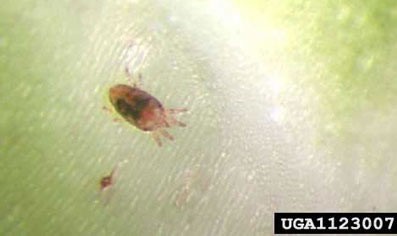Brevipalpus californicus
Scarlet Mite/ Omnivorous Flat Mite
Synonyms: Hystripalpus californicus, Brevipalpus australis, B. browningi, B. confusis, B. woglumi,
Tenuipalpus vitis, T. australis, T. californicus
Class: Arachnida
Order: Acari
Family: Tenuipalpidae

Photographer: Rayanne Lehman
Source: http://entomology.ifas.ufl.edu/creatures/orn/mites/Brevipalpus_californicus.htm
Adult Description: The genus Brevipalpus has 300 species worldwide with B. californicus being one of the most significant agricultural pest species within the genus. Even though they are in the “flat mite” family, Tenuipalpidae; Brevipalpus mites are not flat and have a central ridge present. Overall, these reddish-brown mites are often undetected on plants because of their microscopic size (200-400 micrometers) and somewhat sessile behavior. The picture above is of Brevipalpus sp.
Larvae Description: A newly-hatched larva is bright red-orange and ovoid. It can be identified through its three pairs of short stout legs, the first two pairs positioned anteriorly. It then molts into a protonymph which has four pairs of legs and is three times bigger than the larvae with more slender and colorless appendages. Following that stage is the deutonymph is bigger and more slender than the protonymph.
Host Plant: This mite attacks several important crop and ornamental species including: Acacia, Acer, Acineta, Allamanda, Anguloa, Anthurium, Antidesma, Aphelandra, Bletia, Brassia, Callicarpa, Callistemon, Calycanthus, Catasetum, Citrus, Clausena, Clerodendrum, Cocos, Codiaeum, Columnea, Cordia, Cupressus, Crescentia, Croton, Dendrobium, Dodonaea, Dolichos, Epidendrum, Euphorbia, Ficus, Flacourtia, Flaveria, Gardenia, Gongor, Hibiscus, Houlletia, Howea, Ilex, Jacaranda, Ligustrum, Liquidambar, Lycaste, Magnolia, Malus, Melia, Odontoglossum, Peristeria, Persea, Pilea, Podocarpus, Poinsettia, Rhododendron, Sida, Solanum, Stantropea, Tabebuia, Thea, Thunbergia, Trevesia, Trichophila, Vitis, Wisteria.
Ecological Threat: Feeding on plants by these mites can cause loss of chlorophyll, blistering, and necrotic areas on leaves. Also, Brevipalpus mites inject toxic saliva into fruits, leaves, stems, twigs, and bud tissues. The mites suck the sap from the petiole and leaves causing the leaves to become deformed, with a rough, thickened and shriveled appearance. The back of the leaf may appear scorched (turn yellowish brown) and dotted with whitish feeding punctures. During heavy infestation stunting occurs, which prevents the crops from developing properly. Feeding damage by Brevipalpus mites on citrus in Texas is most prevalent on inside fruit in the lower tree canopy. Finally, a few Brevipalpus species (including B. californicus) have been known to transmit viral diseases such as Citrus leprosis to host plants. Consequently, the combination of this mites’ ability to deform, stunt, poison and transmit viruses to several important crops and flowers makes B. californicus a serious threat,
Biology: Females lay eggs singularly, but usually in a similar location with other females. Usually they are laid in the hollow cavities of the leaves that are created from the destruction of mesophyll. In warm to temperate regions, 4 to 6 generation can occur and the maximum expectancy for adults is about 6 weeks.
History: This mite was initially described feeding on oranges out of Redlands, California in 1904 as Tenuipalpus californicus. In the 1920s this mite nearly destroyed the citrus industry in Florida, until they used sulfur for mite control. Then in 1946 it was found feeding on orchids in Maryland. By 1949 it was placed into the genus Brevipalpus. June to October 1966, large populations of B. californicus and B.phoenicis caused rind spotting of grapefruit in Texas. Since then it has continued to be a pest in the United States.
U.S. Habitat: In temperate to subtropical areas where citrus trees, orchids and trees from families like Rutaceae, Moraceae and Magnoliaceae.
Distribution
Native Origin: presumably Asia
U.S. Present: AZ, CA, FL, HI, KS, LA, MD and TX
Resembles/Alternatives
Brevipalpus californicus resembles other Brevipalpus species, two of which are also economically important agricultural pests: B. obovatus and B. phoenicis. The three species differ in the number of setae on the gnathosoma, the surface patterns on the propodosoma and if pairs of setae are present on the opisthosoma and the shape of those setae.
Management
Brevipalpus californicus can be managed by biological and chemical means. Unfortunately, the sulfur treatment that was used to control this mite in the 1920s is toxic to other forms of life and can no longer be used as a chemical control. However, there are some miticides that have proven effective on this particular flat mite. For biological control measures, studies have shown several species of predatory phytoseiid mites (like Amblysieus linearis, A. longispinosus or Phytoseius niopponicus) to prey on all stages of development; so they can be also used to control false spider mite populations.
References
Baker, E.W. and Y. Suigong. 1988. A catalog of the false spider mites (Tenuipalpidae: Acari) of the United States. International Journal of Acarology. 14(3):143-155.
Dean, H. A., and N. P. Maxwell. 1967. Spotting of grapefruit as associated with false spider mites. Proc. Rio Grande Valley Hort. Soc. 21: 35-45.
McGregor, E. A. 1916-The privet mite in the south. Jour. Econ. Ent. 9: 556-560, fig. 38, pl. XLIII.
Pritchard AE, Baker EW. 1958. The false spider mites. University of California Publications Entomology 41:175-274.
Internet Sources
http://www.sel.barc.usda.gov/acari/content/brevipalpus/brevi1.htm
http://entomology.ifas.ufl.edu/creatures/orn/mites/Brevipalpus_californicus.htm
http://ucanr.edu/blogs/blogcore/postdetail.cfm?postnum=10470
http://www.fcla.edu/FlaEnt/fe77p265.pdf
 Texas Invasive Species Institute
Texas Invasive Species Institute